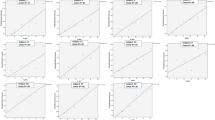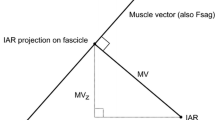Abstract
We designed this experimental study to investigate tissue motions and thus infer the recruitment pattern of the ventral neck muscles [sternocleidomastoid (SCM), longus capitis (Lca), and longus colli (Lco)] at the C4–C5 level in healthy volunteers during isometric manual resistance of the head in flexion in a seated position. This exercise is used in the physiotherapeutic treatment of neck pain and is assumed to activate the deep ventral muscles, but the assumption has not been clearly evaluated. Neck flexors of 16 healthy volunteers (mean age 24 years, SD 3.7) were measured using ultrasonography with strain and strain rate (SR) tissue velocity imaging (TVI) during isometric contraction of flexor muscles. TVI involves using Doppler imaging to study tissue dynamics. All three muscles showed a deformation compared to rest. Except for the initial contraction phase, Lco exhibited a lower strain than Lca and SCM but was the only muscle with a significant change in SR between the phases. When the beginning of the contraction phase was analysed, Lco was the first to be deformed among most volunteers, followed by Lca and then SCM. The exercise investigated seems to be useful as a “stabilizing” exercise for Lco. Our suggestion is that in further research, Lco and Lca should be investigated as separate muscles. TVI could be used to study tissue motions and thus serve as an indicator of muscle patterning between the neck flexors, with the possibility of separating Lco and Lca.




Similar content being viewed by others
References
Blazevich AJ, Gill ND, Zhou S (2006) Intra- and intermuscular variation in human quadriceps femoris architecture assessed in vivo. J Anat 209:289–310
Boyd-Clark LC, Briggs CA, Galea MP (2002) Muscle spindle distribution, morphology, and density in longus colli and multifidus muscles of the cervical spine. Spine 27:694–701
Brodin L-Å (2004) Tissue Doppler, a fundamental tool for parametric imaging. Clin Physiol Funct Imaging 24:147–155
Cagnie B, Dickx N, Peeters I, Tuytens J, Achten E, Cambier D et al (2008) The use of functional MRI to evaluate cervical flexor activity during different cervical flexion exercises. J Appl Physiol 104:230–235
Cagnie B, Derese E, Vandamme L, Verstraete K, Cambier D, Daneels L (2009) Validity and reliability of ultrasonography for the longus colli in asymptomatic subjects. Man Ther 14:421–426
Chino K, Oda T, Kurihara T, Nagayoshi T, Yoshikawa K, Kanehisa H et al (2008) In vivo fascicle behavior of synergistic muscles in concentric and eccentric plantar flexions in humans. J Electromyogr Kinesiol 18:79–88
Choi H, Vanderby R (2000) Muscle forces and spinal loads at C4/5 level during isometric voluntary efforts. Med Sci Sports Exerc 32:830–838
Conley MS, Meyer RA, Bloomberg JJ, Feeback DL, Dudley GA (1995) Noninvasive analysis of human neck muscle function. Spine 20:2505–2512
Croft PR, Macfarlane GJ, Papageorgiou AC, Thomas E, Silman AJ (1998) Outcome of low back pain in general practice: a prospective study. BMJ 316:1356–1359
D’Hooge J, Heimdal A, Jamal F, Kukulski T, Bijnens B, Rademakers F et al (2000) Regional strain and strain rate measurements by cardiac ultrasound: principles, implementation and limitations. Eur J Echocardiogr 1:154–170
Elliott JM, Jull GA, Noteboom JT, Durbridge GL, Gibbon WW (2007) Magnetic resonance imaging study of cross-sectional area of the extensor musculature in an asymptomatic cohort. Clin Anat 20:35–40
Fairbank JCT, Couper J, Davies JB, O′Brien JP (1980) The Oswestry low back pain disability questionnaire. Phys Ther 70:97–114
Falla D, Bilenkij G, Jull G (2004a) Patients with chronic neck pain demonstrate altered patterns of muscle activation during performance of a functional upper limb task. Spine 29:1436–1440
Falla D, Jull G, Edwards S, Koh K, Rainoldi A (2004b) Neuromuscular efficiency of the sternocleidomastoid and anterior scalene muscles in patients with chronic neck pain. Disabil Rehabil 26:712–717
Falla D, Jull G, Hodges PW (2004c) Feedforward activity of the cervical flexor muscles during voluntary arm movements is delayed in chronic neck pain. Exp Brain Res 157:43–48
Falla D, Jull G, Hodges P, Vicenzino B (2006) An endurance-strength training regime is effective in reducing myoelectric manifestations of cervical flexor muscle fatigue in females with chronic neck pain. Clin Neurophysiol 117:828–837
Falla D, Jull G, Russell T, Vicenzino B, Hodges P (2007a) Effect of neck exercise on sitting posture in patients with chronic neck pain. Phys Ther 87:408–417
Falla D, O’Leary S, Fagan A, Jull G (2007b) Recruitment pattern of the deep cervical flexor muscles during a postural correction exercise performed in sitting. Man Ther 12:139–143
Fukunaga T, Ichinose Y, Ito M, Kawakami Y, Fukashiro S (1997) Determination of fascicle length and pennation in a contracting human muscle in vivo. J Appl Physiol 82:354–358
Grubb NR, Fleming A, Sutherland GR, Fox KA (1995) Skeletal muscle contraction in healthy volunteers: assessment with Doppler tissue imaging. Radiology 194:837–842
Heimdal A, Støylen A, Torp H, Skjaerpe T (1998) Real-time strain rate imaging of the left ventricle by ultrasound. J Am Soc Echocardiogr 11:1013–1019
Jesus F, Ferreira PH, Ferreira M (2008) Ultrasonographic measurement of neck muscle recruitment: a preliminary investigation. J Man Manip Ther 16:89–92
Johnston V, Jull G, Souvlis T, Jimmieson NL (2008) Neck movement and muscle activity characteristics in female office workers with neck pain. Spine 33:555–563
Jull G, Kristjansson E, DallÀlba P (2004a) Impairment in the cervical flexors: a comparison of whiplash and insidious onset neck pain patients. Man Ther 9:89–94
Jull G, Falla D, Treleaven J, Sterling M, O’Leary S (2004b) A therapeutic exercise approach for cervical disorders. In: Boyling JD, Jull G (eds) Grieve’s modern manual therapy. The vertebral column. Churchill–Livingstone, Edinburgh, pp 451–469
Kawakami Y, Abe T, Kanehisa H, Fukunaga T (2006) Human skeletal muscle size and architecture: variability and interdependence. Am J Hum Biol 18:845–848
Kay TM, Gross A, Goldsmith C, Santaguida PL, Hoving J, Brinfort G et al (2005) Exercises for mechanical neck disorders. Cochrane Database Syst Rev (3):CD004250
Mannion AF, Pulkovski N, Schenk P, Hodges PW, Gerber H, Loupas T et al (2008) A new method for the noninvasive determination of abdominal muscle feedforward activity based on tissue velocity information from tissue Doppler imaging. J Appl Physiol 104:1192–1201
Mayoux-Benhamou MA, Revel M, Roudier R, Barbet JP, Bargy F (1994) Longus colli has a postural function on cervical curvature. Surg Radiol Anat 16:367–371
Mirsky I, Parmley WW (1973) Assessment of passive elastic stiffness for isolated heart muscle and the intact heart. Circ Res 33:233–243
Narici M (1999) Human skeletal muscle architecture studied in vivo by non-invasive imaging techniques: functional significance and applications. J Electromyogr Kinesiol 9:97–103
O’Leary S, Jull G, Mehwa K, Vicenzino B (2007) Specificity in retraining craniocervical flexor muscle performance. J Orthop Sports Phys Ther 37:3–9
Oda T, Himeno RC, Hay D, Chino K, Kurihara T, Nagayoshi T et al (2007) In vivo behavior of muscle fascicles and tendinous tissues in human tibialis anterior muscle during twitch contraction. J Biomech 40:3114–3120
Panjabi MM, Cholewicki J, Nibu K, Grauer J, Babat LB, Dvorak J (1998) Critical load of the human cervical spine: an in vitro experimental study. Clin Biomech 13:11–17
Peolsson A, Almkvist C, Dahlberg C, Lindqvist S, Pettersson S (2007) Age- and sex-specific reference values of a test of neck muscle endurance. J Manip Physiol Ther 30:171–177
Peolsson M, Larsson B, Brodin LA, Gerdle B (2008) A pilot study using tissue velocity ultrasound imaging (TVI) to assess muscle activity pattern in patients with chronic trapezius myalgia. BMC Musculoskelet Disord 9:127–141
Pulkovski N, Schenk P, Maffiuletti NA, Mannion AF (2008) Tissue Doppler imaging for detecting onset of muscle activity. Muscle Nerve 37:638–649
Rankin G, Stokes M, Newham DJ (2005) Size and shape of the posterior neck muscles measured by ultrasound imaging: normal values in males and females of different ages. Man Ther 10:108–115
Scott J, Huskisson EC (1976) Graphic representation of pain. Pain 2:175–184
Stoylen A (2001) Strain rate imaging of the left ventricle by ultrasound: Feasibility, clinical validation and physiological aspects. Dissertation, NTNU, Norwegian University of Science and Technology, Trondheim
Vasavada A (1998) Influence of muscle morphometry and moment arms on the moment-generating capacity of human neck muscles. Spine 23:412–422
Vernon H, Mior S (1991) The neck disability index: a study of reliability and validity. J Manip Physiol Ther 14:409–415
Acknowledgments
All procedures were conducted according to the Declaration of Helsinki. The experiments complied with the current laws of Sweden, and the study was approved by the Ethics Committee at the Faculty of Health Sciences, Linköping University.
Conflict of interest statement
The authors declare that they have no conflict of interest.
Author information
Authors and Affiliations
Corresponding author
Additional information
Communicated by Arnold de Haan.
Rights and permissions
About this article
Cite this article
Peolsson, M., Brodin, LÅ. & Peolsson, A. Tissue motion pattern of ventral neck muscles investigated by tissue velocity ultrasonography imaging. Eur J Appl Physiol 109, 899–908 (2010). https://doi.org/10.1007/s00421-010-1420-z
Accepted:
Published:
Issue Date:
DOI: https://doi.org/10.1007/s00421-010-1420-z




